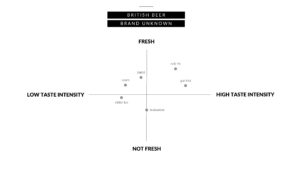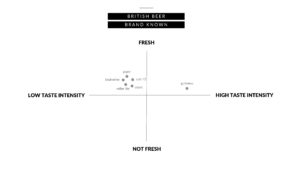READING TIME: 3 MINUTES
To me, brand management is the most powerful tool when it comes to shaping a company’s reputation. For many marketers though, “branding”, “brand management”, or sometimes also called “brand building” is something intangible. It’s something that is hard to understand and even harder to practice. In this series of articles, I want to provide you with the very basics of branding. Read this first post and get introduced to the number one principle of successful brand management: Differentiation.
The art of being different
No doubt: The world’s most famous and successful brands are the ones, which are different, stand out from the rest and are at the same time highly relevant for the target audiences. The right brand strategy helps marketers and brand managers to keep their brand in the customer’s relevant set. Brands aren’t unique by accident, but because of the fact that the marketing & communications team managed to find the sweet spot in terms of market positioning. An easy but still very effective way to find this sweet spot is to employ a gap analysis based on a perceptual map. To create such a map, spot the two most influential characteristics, by which people assess the value of your products. But let’s take an example to make this exercise clearer.
Basics of branding: Perceptual maps for gap analysis
The two following perceptual maps illustrate the results of a customer survey, which focused on the positioning of some of the most famous British beer brands. People had to taste 6 different beers from 6 different brands and were told to locate their tasting experience in a perceptual map. The participants of this survey were separated into two groups. One group did a blind tasting and the other one was aware of the corresponding brands. The first map illustrates the results of the blind tasting. The second one shows the results of the tasting where the brands were known.


Speaking about the basics of branding, this example perfectly proofs that brands are more than just a logo and a slogan. John-Noël Kapferer, author of the book „The New Strategic Brand Management“ puts it simply and states:
„A brand is a name with the power to influence“, John-Noël Kapferer
I love this plain definition, because it covers the essence of what brand management is supposed to achieve. The beer brand case perfectly demonstrates this: The reason why the survey results significantly differed from one group to another was the fact that one group was aware of the beers’ corresponding brands. This knowledge fundamentally influenced the participants. They declared Guinness as the single most unique beer brand within the sample, although the participants of the blind tasting came to a completely different conclusion. They did so because they already had expectations and (positive) prejudices and were at the same time emotionally bonded to a certain brand.
Points of parity vs. points of difference
And now we get to the core of the whole story: The way how brands are perceived by their target groups, depends on how well points of parity and points of difference match. When brands act and communicate in a way, where they aim to exactly meet their customer’s expectations, they focus on points of parity. Points of parity are defined based on extrinsic factors and lead to an outside-in direction in terms of brand communications.
Points of difference on the contrary are defined by the brand itself (inside-out). They embody a brand’s truly unique and authentic values in regard to the product claim and reflect the brand’s personality and most inner beliefs.
Balancing customer expectations and the autonomy of a brand, is a daily challenge and often hard to achieve. Still, marketers need to keep in mind that only well balanced points of difference and points of parity lead to a strong and successful brand. With every campaign and every single marketing activity, brand builders need to consider these simple basics of branding. Whenever possible, they should ask themselves if they communicate their points of difference accordingly and if their target audience is able to remember them.
Brand builders who seek for creating unique brands should think about using perceptual maps for gap analysis and need to strive for well balanced points of parity/difference. Still, there are many more factors, which are crucial when we speak about the basics of branding. In my next article I’m going to focus on the principle of consistency in brand communications. Subscribe to my newsletter and get every new article straight in your inbox.
Sources:
Franz Drack: Lecture handout brand management keynote




Be First to Comment